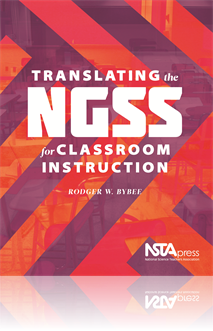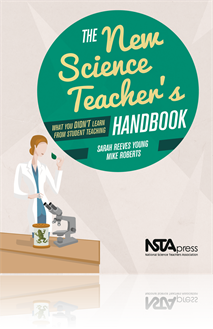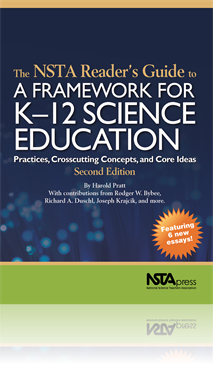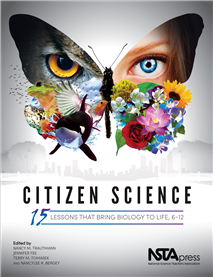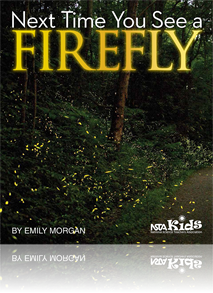All Book Chapters
Book Chapter
This chapter will help state science supervisors, district science coordinators, and school science teachers with the process of adapting instructional materials to accommodate the Next Generation Science Standards (NGSS). The science education comm...
Book Chapter
Planning to ADAPT Materials for Classroom Instruction
For this chapter, the goals are to identify the degree to which current instructional materials accommodate performance expectations from Next Generation Science Standards (NGSS) and to adapt these materials into a unit of instruction that is usable...
Book Chapter
NGSS Frequently Stated Concerns: The Yes, Buts
In this chapter, some of the Yes, but concerns are addressed. Some of the referents for the concerns lie beyond the Next Generation Science Standards (NGSS) and are the result of other variables, such as national politics, state budgets, or local pr...
Book Chapter
The Next Generation Science Standards (NGSS) raise the academic bar for states and still leave them with the freedom to adopt or adapt materials and provide professional development to attain higher levels of achievement—for all students. The NGSS...
Book Chapter
Appendix A: Grade 5 NGSS Unit, “Is It a New Substance?”
In this unit, students conduct an investigation to determine if two substances combine to form a new substance. The students mix Substance W with a solution of Substance X dissolved in water. They need to complete the investigation to gather evidence...
Book Chapter
Appendix B: Middle School NGSS Unit, “Water and Hydrogen Peroxide”
Water molecules and hydrogen peroxide molecules each consist of only hydrogen and oxygen atoms. A water molecule consists of two hydrogen atoms and one oxygen atom. A hydrogen peroxide molecule consists of two hydrogen atoms and two oxygen atoms. In ...
Book Chapter
Appendix C: High School NGSS Unit, “The Haber-Bosch Process”
A chemist named Fritz Haber developed a process to produce ammonia directly from hydrogen and nitrogen as shown in the equation. An engineer named Karl Bosch designed the equipment needed for the process, and today the Haber-Bosch process is the prim...
Book Chapter
From NGSS to Classroom Instruction
This chapter provides a context for translating standards into something understandable, manageable, and usable for those with the real task of teaching science. In the first sections, the chapter progresses from a brief discussion of the disciplinar...
Book Chapter
The purpose of the assessment probe, in this chapter, is to elicit children’s developing ideas about structure in living systems. The probe is designed to find out if students recognize that living things are made up of parts. The sample chapter al...
Book Chapter
The purpose of the assessment probe, in this chapter, is to elicit children’s ideas about plants. The probe is designed to find out what characteristics children use to decide if something is a plant....
Book Chapter
The purpose of the assessment probe, in this chapter, is to elicit children’s ideas about needs of living things. The probe is designed to find out if students recognize that all animals need air to live, including animals that live under water....
Book Chapter
The purpose of the assessment probe, in this chapter, is to elicit children’s ideas about sensory responses. The probe is designed to reveal whether students recognize that plants as well as animals can sense information from their environment and...
Book Chapter
The purpose of the assessment probe, in this chapter, is to elicit children’s ideas about seed germination. The probe is designed to find out if children think the size of a seed determines the time it takes to germinate and grow....
Book Chapter
The purpose of the assessment probe, in this chapter, is to elicit children’s ideas about floating and sinking. The probe is designed to find out if children think size is the property that determines whether an object floats or sinks....
Book Chapter
The purpose of the assessment probe, in this chapter, is to elicit children’s ideas about conservation of matter. The probe is designed to find out if students recognize that all the individual parts that make up an object taken together weigh the...
Book Chapter
The purpose of the assessment probe, in this chapter, is to elicit children’s ideas about changes in matter. The probe is designed to reveal whether students recognize that not all changes are reversible....
Book Chapter
The purpose of the assessment probe, in this chapter, is to elicit children’s descriptions of motion. The probe is designed to reveal how students describe the path of a moving object as it leaves a winding track....
Book Chapter
The purpose of the assessment probe, in this chapter, is to elicit children’s ideas about waves. The probe is designed to reveal students’ ideas about water waves and the waves’ interactions with floating objects....
Book Chapter
The purpose of the assessment probe, in this chapter, is to elicit children’s ideas about variations in sound. The probe is designed to reveal students’ thinking about factors that affect pitch....
Book Chapter
The purpose of the assessment probe, in this chapter, is to elicit children’s ideas about magnets. The probe is designed to reveal children’s ideas about the strength of a magnet in relation to the size of the magnet....
Book Chapter
The purpose of the assessment probe, in this chapter, is to elicit children’s ideas about the Earth materials that make up landforms. The probe is designed to reveal whether students recognize that mountains are made primarily of rock—a precursor...
Book Chapter
The purpose of the assessment probe in this chapter, is to elicit children’s ideas about soil. The probe is designed to find out if students recognize that soil is made up of living and nonliving material....
Book Chapter
Into the Jungle: A Guide to Investigating Your New Science Classroom
This chapter is all about what to do when you are given your first classroom. As a science teacher, you often inherit a jungle of supplies that are organized in a way that only one person would understand … and that person is most likely retired an...
Book Chapter
Working With a Mentor: How to Approach the Relationship
This chapter is about how to go about creating a working relationship with a mentor teacher. Most new teachers are assigned mentor teachers, who get the position based on the number of years they have worked in a school, not necessarily their ability...
Book Chapter
Life on a Budget: How to Use Your Money for Classroom Supplies Wisely
This chapter details how new teachers can make the best use of their science classroom funds, no matter how small the budget. The chapter outlines how a teacher can spend wisely throughout the year, use community resources for free gear, and know wha...
Book Chapter
Classroom Management 101: Easy Steps to Big Success
This chapter focuses on common classroom management techniques used by science teachers who allow for inquiry and hands-on learning in a controlled environment. The chapter looks at how young teachers can establish routines that allow them to apply t...
Book Chapter
Lab Safety: More Than Just Goggles
Every science classroom visited has always had a safety rules poster clearly displayed. As a new teacher, I assumed these were issued to every science teacher upon graduation. Hands-on science requires safe practices—a message that was resonated lo...
Book Chapter
This chapter looks at the role that parents play in the life of a new teacher. It highlights back-to-school night, parent-teacher conferences, and how to engage parents as a resource for teaching science. Additionally, tips on how to establish bounda...
Book Chapter
The Grading Dilemma: Balancing Great Ideas With a Manageable Paper Load
This chapter centers on finding a balance between all the great lessons created in the classroom and all the paperwork said lesson leaves behind. So, how do you avoid the mountain of papers as a new teacher? Specific assessment approaches that can be...
Book Chapter
Getting to Know Your Students Outside of the Classroom: Coaching and Community
This chapter focuses on interacting with students outside of the classroom to improve the effectiveness of teaching. It highlights engagements through coaching (athletics and academic groups like FIRST LEGO League and Science Olympiad), as well as co...
Book Chapter
Professional Development: Learning to Always Be a Student
“If you are going to be a teacher, you should always be a student.” This quote has directed my entire career in education, and continues to drive my actions today. I share it with every single new teacher that I meet in the hopes that it translat...
Book Chapter
Calling in Sick: What to Do When You Are Out of the Classroom
Whether you have been teaching for 1 year or 50, no one likes to miss class. But circumstances will arise throughout the school year that will require you to turn your beloved students over to someone else. And while the thought of this might be scar...
Book Chapter
Interdisciplinary Work: Don't Be Afraid of the Good Teachers
This chapter focuses on how to collaborate with other teachers in your classroom. It provides a guide for identifying teachers to work with, as well as good strategies for building interdisciplinary units with your colleagues. These steps can be used...
Book Chapter
Surviving Year One and Transitioning into Thriving in Year Two and Beyond
As you finish your rookie season in the world of education, every first-year teacher deserves a hearty congratulation. Everyone will tell you that their first year was the most challenging… what they often omit is that their second year was second ...
Book Chapter
Leadership for New Teachers: How to Turn the Job Into a Career
Finally, this chapter talks about how to translate your enthusiasm and energy into becoming a young leader in the world of science education. It will look at possible future career aspirations that science teachers can have, and how to achieve those ...
Book Chapter
The purpose of the assessment probe, in this chapter, is to elicit children's ideas about the needs of seeds. The probe is designed to find out if students recognize that when seeds are planted in soil, they need to take in water from the soil in ord...
Book Chapter
Obtaining, Evaluating, and Communicating Information
The authors hope this chapter can open up a discussion with science educators in all areas of the system—from K–12 schools to informal science institutions and afterschool learning environments—about the varied ways to provide opportunities for...
Book Chapter
Starting Class the Right Way: Starter Activities
A successful class period is often made within the first few minutes, and this chapter will detail effective and engaging science-based starter activities. These 10-minute teaching ideas, including “Admit Slip, Please!,” “Inner/Outer Circle,”...
Book Chapter
Bird Migration Patterns in My Area
In this chapter, students consider indicators of climate change, interpret various representations of eBird citizen science data, and reflect on how their actions as citizen scientists can assist in better understanding bird migration as a local indi...
Book Chapter
Fireflies are one of the most fascinating insects because of their ability to produce light inside their bodies. Have you ever wondered why fireflies flash?This sample from Next Time You See a Firefly gives you a tease of what the whole books is abou...



